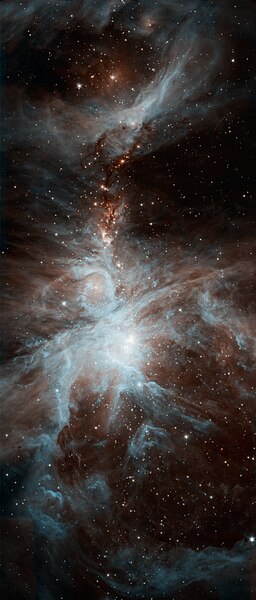চিত্র:Spitzer's Orion.jpg

এই প্রাকদর্শনের আকার: ২৫৬ × ৬০০ পিক্সেল। অন্যান্য আকারসমূহ: ১০২ × ২৪০ পিক্সেল | ২০৫ × ৪৮০ পিক্সেল | ৩২৮ × ৭৬৮ পিক্সেল | ৪৩৭ × ১,০২৪ পিক্সেল | ২,১৭১ × ৫,০৮৫ পিক্সেল।
পূর্ণ রেজোলিউশন (২,১৭১ × ৫,০৮৫ পিক্সেল, ফাইলের আকার: ১.৪৪ মেগাবাইট, এমআইএমই ধরন: image/jpeg)
ফাইলের ইতিহাস
যেকোনো তারিখ/সময়ে ক্লিক করে দেখুন ফাইলটি তখন কী অবস্থায় ছিল।
| তারিখ/সময় | সংক্ষেপচিত্র | মাত্রা | ব্যবহারকারী | মন্তব্য | |
|---|---|---|---|---|---|
| বর্তমান | ১০:৩১, ১০ এপ্রিল ২০১০ |  | ২,১৭১ × ৫,০৮৫ (১.৪৪ মেগাবাইট) | Originalwana | {{Information |Description={{en|1=A colony of hot, young stars is stirring up the cosmic scene in this new picture from NASA's Spitzer Space Telescope. The image shows the Orion nebula, a happening place where stars are born. The young s |
সংযোগসমূহ
নিচের পৃষ্ঠা(গুলো) থেকে এই ছবিতে সংযোগ আছে:
ফাইলের বৈশ্বিক ব্যবহার
নিচের অন্যান্য উইকিগুলো এই ফাইলটি ব্যবহার করে:
- ba.wikipedia.org-এ ব্যবহার
- crh.wikipedia.org-এ ব্যবহার
- cv.wikipedia.org-এ ব্যবহার
- el.wikipedia.org-এ ব্যবহার
- en.wikipedia.org-এ ব্যবহার
- fa.wikipedia.org-এ ব্যবহার
- سحابی شکارچی
- ویکیپدیا:نگارههای پیشنهادی/ستارهشناسی
- ویکیپدیا:نگاره روز/اکتبر ۲۰۱۳
- کاربر:MMjex/نگارههای برگزیده
- ویکیپدیا:گزیدن نگاره برگزیده/مه-۲۰۱۳
- ویکیپدیا:گزیدن نگاره برگزیده/Spitzer's Orion.jpg
- الگو:نر/2013-10-30
- الگو:نر محافظت شده/2013-10-30
- بحث کاربر:MMjex/بایگانی ۱
- ویکیپدیا:نگارههای برگزیده/نگاه به فضا
- fr.wikipedia.org-এ ব্যবহার
- hu.wikipedia.org-এ ব্যবহার
- is.wikipedia.org-এ ব্যবহার
- it.wikipedia.org-এ ব্যবহার
- ko.wikipedia.org-এ ব্যবহার
- krc.wikipedia.org-এ ব্যবহার
- lbe.wikipedia.org-এ ব্যবহার
- mk.wikipedia.org-এ ব্যবহার
- my.wikipedia.org-এ ব্যবহার
- no.wikibooks.org-এ ব্যবহার
- os.wikipedia.org-এ ব্যবহার
- pl.wikipedia.org-এ ব্যবহার
- ro.wikipedia.org-এ ব্যবহার
- ru.wikipedia.org-এ ব্যবহার
- ru.wikinews.org-এ ব্যবহার
- sah.wikipedia.org-এ ব্যবহার
- sr.wikipedia.org-এ ব্যবহার
- uk.wikipedia.org-এ ব্যবহার
- vi.wikipedia.org-এ ব্যবহার
- xal.wikipedia.org-এ ব্যবহার
- zh.wikipedia.org-এ ব্যবহার



